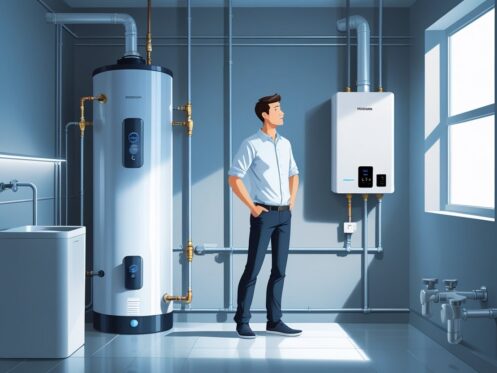Considering a switch to a tankless water heater? Making this change can lead to increased energy efficiency and a more consistent supply of hot water for your needs. Unlike traditional tank heaters, tankless options heat water on demand, which means you can enjoy hot showers without worrying about running out of hot water.
Many homeowners are unaware that switching to a tankless system can also save space. They are compact and can be installed in various locations throughout your home, freeing up valuable storage space. If you’re looking for ways to improve your home’s efficiency, this option is worth considering.
At Splash Plumbing, we understand the factors that come into play when choosing a water heater. Whether you’re motivated by energy savings or maximizing your living space, our experienced team is here to help you make an informed decision tailored to your needs.
How Tankless Water Heaters Work
Tankless water heaters offer an efficient way to provide hot water on demand without the limitations of traditional tanks. Understanding how they function can help you make an informed decision about whether to switch.
On-Demand Hot Water Technology
A tankless water heater heats water only when you need it. This system uses advanced technology to deliver hot water on demand. When you turn on the tap, cold water travels through a pipe into the unit. A sensing device activates the heating elements, warming the water instantly. This results in a continuous supply of hot water, eliminating the risk of running out, which can be a concern with tanks.
Moreover, these units are compact, allowing you to save space by installing them on a wall. You can enjoy endless hot water for showers, washing, and other needs simultaneously.
Heat Exchange and Heating Elements
The core of a tankless system lies in its heat exchanger, a component that plays a crucial role in quickly heating incoming water. Most units utilize either gas burners or electric heating elements.
Gas units typically heat water more rapidly and have higher flow rates, making them suitable for larger households with multiple demands. Electric systems are often easier to install and maintain but may have lower output. Understanding these differences helps you choose the right option based on your household’s hot water needs.
Types of Tankless Units
There are primarily two types of tankless units: whole-house and point-of-use. Whole-house systems are designed to meet the hot water demands of an entire home. They are typically installed in a central location for maximum efficiency, providing continuous hot water throughout the house.
Point-of-use units, on the other hand, are smaller and installed closer to the tap. These are ideal for single applications, such as a bathroom or kitchen sink. Depending on the size of your home and your hot water needs, you can choose to install multiple units for optimal performance.
Consider consulting professionals like Splash Plumbing for guidance tailored to your household requirements.
Benefits of Switching to a Tankless Water Heater
Switching to a tankless water heater offers several advantages that cater to energy efficiency, space-saving needs, and durability. These benefits can enhance your home’s hot water delivery while potentially reducing utility costs.
Energy Efficiency and Cost Savings
Tankless water heaters are known for their energy efficiency. Unlike traditional tanks that continuously heat water, tankless systems provide hot water on demand, significantly reducing standby heat loss. This efficiency can lead to energy savings of up to 34%, translating into lower utility bills. With a lower flow rate, these systems also ensure that you only pay for the hot water you use. Making the switch can be a smart financial decision, as many users notice a decrease in their energy costs shortly after installation. Investing in energy-efficient solutions not only benefits your wallet but also supports environmental sustainability.
Space-Saving and Compact Design
The compact design of tankless water heaters allows you to save valuable space in your home. These units can be mounted on walls, making them ideal for homes with limited space. By opting for a space-saving design, you can utilize the area that was previously occupied by a bulky tank. This flexibility opens up possibilities for storage or adds more room for other household needs. Additionally, their smaller size does not compromise performance; they supply an uninterrupted hot water flow, making them a practical choice for modern living.
Longer Lifespan and Durability
Tankless water heaters typically have a longer lifespan compared to conventional water heaters. While traditional tanks may last around 10-15 years, tankless models can function effectively for 20 years or more with proper maintenance. This durability means fewer replacements and service calls, ultimately saving you money in the long run. Regular maintenance, including descaling to prevent mineral buildup, will further extend the life of your unit. For homeowners wanting reliability, the long-lasting nature of these systems makes them an appealing choice. If you need help with installation, consider reaching out to Splash Plumbing for expertise and quality service.
Factors to Consider Before Making the Switch
Switching to a tankless water heater involves various critical factors that can affect your home’s plumbing and comfort. Understanding installation requirements, analyzing your hot water demand, evaluating costs, and acknowledging limitations will help ensure a smooth transition.
Installation Requirements and Process
Before switching, it’s essential to assess the installation requirements. Tankless water heaters may necessitate upgrades to your gas line or electrical connection. The size of your unit will depend on your household’s hot water needs and may require a professional assessment for optimal fitting.
The installation process typically involves mounting the unit on a wall, connecting the necessary pipes, and ensuring proper venting. Professional assistance is often recommended, as improper installation can lead to significant issues. A qualified plumber from Splash Plumbing can guide you through this process efficiently.
Hot Water Demand and Flow Rate
Understanding your household’s hot water demand is crucial. Tankless systems provide hot water on demand, but their flow rate varies by model. Calculate your peak usage times, especially if multiple outlets will be used simultaneously, such as showers and dishwashers.
You’ll want a unit that can accommodate your usage patterns without disrupting hot water availability. Consulting with an expert can help you determine the appropriate flow rate and ensure that your tankless unit meets your specific hot water needs.
Unit Cost and Rebates
The unit cost for a tankless water heater typically ranges from $1,000 to $3,000, excluding installation expenses. Initial investment might seem high compared to traditional water heaters, but consider the long-term savings on energy bills due to their efficiency.
Check for available rebates or tax incentives which can considerably offset costs. Programs differ by location, so you may find benefits that make the switch more financially feasible. A thorough review of local incentives can provide additional motivation for your decision.
Limitations and Potential Drawbacks
While tankless water heaters offer advantages, there are limitations to consider. They may not deliver consistent hot water to multiple outlets during peak demand unless appropriately sized. This can lead to cold water when several taps are in use simultaneously.
Another consideration is maintenance—tankless units typically require descaling more frequently, especially in areas with hard water. Understanding these potential drawbacks can assist you in making an informed decision. Consulting with a professional can provide clarity on whether a tankless option aligns with your household’s requirements.
Comparing Tankless and Traditional Water Heaters
When considering a water heater, it’s essential to evaluate the differences between tankless and traditional options. Each type has its distinct benefits and drawbacks that can impact efficiency, cost, and convenience.
Tankless vs. Storage Tank Models
Tankless water heaters provide hot water on demand, eliminating the need for a storage tank. This results in a compact design that can save space and enhance installation flexibility. In contrast, traditional tank-style water heaters continuously heat and store water, leading to potential energy waste when not in use.
Tankless models can deliver endless hot water, making them suitable for larger households. Traditional models, however, have the advantage of lower initial costs. While the installation of tankless heaters might be higher, their efficiency often compensates over time, particularly for household needs.
Energy Costs and Savings Analysis
Energy costs vary significantly between these two types. Tankless water heaters are generally more energy-efficient because they only heat water as needed. This can lead to reduced energy bills, especially in homes that consume a lot of hot water. According to energy reports, tankless water heaters can be up to 30% more efficient than traditional models.
On the other hand, traditional water heaters have a standby heat loss, meaning they use energy to keep water hot even when not in use. This can add up quickly, increasing your utility bills. It’s essential to analyze your hot water usage to determine which option could save you more in the long run.
Longevity and Maintenance Requirements
When it comes to longevity, tankless water heaters can last 20 to 30 years, significantly outlasting traditional tank models, which typically have a lifespan of 10 to 15 years. This longevity can make tankless options a more cost-effective choice over time, despite their higher initial investment.
Maintenance is another consideration. Tankless systems often require regular descaling to prevent mineral buildup, especially in areas with hard water. Traditional water heaters may need occasional flushing to remove sediment but often require less frequent upkeep. Consulting a professional service like Splash Plumbing ensures effective maintenance for your specific water heater needs, keeping your system running smoothly and efficiently.
Types of Tankless Water Heaters and Fuel Options
Choosing a tankless water heater involves understanding the various types and fuel options available. Each option has its benefits and considerations that can impact your decision.
Gas Tankless Water Heaters
Gas tankless water heaters use natural gas or propane to heat water on demand. They provide a continuous supply of hot water, making them ideal for larger households or heavy-use scenarios. Installing a gas-powered tankless heater can be cost-effective in the long run, especially if you have access to natural gas, as it generally offers lower operating costs than electricity.
When considering installation, it’s crucial to ensure proper venting to ensure safety and compliance with local regulations. Additionally, some models are designed for easy retrofitting in existing gas setups, enhancing versatility.
Electric Tankless Water Heaters
Electric tankless water heaters provide an alternative for homes without gas lines. They operate by heating water with electric elements, making them easier to install. These models are compact and can fit into tighter spaces.
While electric tankless water heaters often have a lower upfront cost, they can result in higher energy bills due to electricity being generally more expensive than gas. Assess your household’s water needs and electric capability to determine compatibility before choosing this option.
Condensing and Non-Condensing Models
Tankless water heaters can also be categorized as condensing or non-condensing models. Condensing units are more efficient as they use the heat from exhaust gases to preheat incoming water, improving efficiency ratings. This type can result in substantial energy savings.
Non-condensing models, on the other hand, are typically less expensive but may waste energy through their exhaust. Choose a condensing model if energy efficiency is a priority in your decision-making process. If you’re unsure which model suits your needs, consult with professionals like Splash Plumbing to find the best fit.
Installation, Maintenance, and Safety Considerations
When considering a switch to a tankless water heater, understanding installation, maintenance, and safety is crucial. These factors can significantly impact your home’s efficiency, safety, and overall functionality. Below are important points you need to consider.
Venting and Ventilation Needs
Proper venting is essential for gas-powered tankless water heaters. These units require specific vent sizes and materials to ensure safe operation. A direct vent system is commonly used, which pulls air from outside and expels exhaust gases.
Consult the U.S. Department of Energy guidelines for recommended venting practices. Be aware that improper installation can lead to gas leaks or carbon monoxide hazards. If the installation is beyond your expertise, seek professional assistance. At Splash Plumbing, technicians are trained to ensure your heater meets all safety criteria.
Preventing Leaks and Water Damage
Leaks can cause significant water damage if not managed properly. During installation, ensure all connections are secure. Check for potential leak points, such as joints and piping.
Consider installing a leak detection system that can alert you when water is present where it shouldn’t be. This proactive measure can save you money and prevent damage in the long run. Regular checks can help identify problems before they escalate, reducing the risk of water damage to your property.
Regular Maintenance and Longevity
Regular maintenance is vital to keep your tankless water heater functioning efficiently. This includes flushing the unit annually to remove mineral buildup. Hard water areas may require more frequent maintenance.
Inspect filters and venting for blockages or wear. Following the manufacturer’s guidelines ensures longevity. Brands such as Rinnai, Rheem, and Noritz often provide maintenance recommendations specific to their models. It’s advisable to schedule professional maintenance through a trusted provider like Splash Plumbing to ensure your system operates optimally.
Brand Considerations and Professional Assistance
When selecting a tankless water heater, consider reputable brands. Rinnai, Rheem, and Noritz are known for reliability and efficiency. Each offers different models suited to various household needs.
Professional installation is also important. Hiring a qualified plumber ensures compliance with local codes and safety. A poorly installed unit can lead to issues like inefficient heating or safety hazards. Choose a licensed plumber who specializes in tankless systems to guarantee a reliable installation and peace of mind.
Frequently Asked Questions
When considering a switch to a tankless water heater, you might have specific inquiries. Understanding the pros and cons, costs, installation factors, and sizing will help you make an informed decision.
What are the pros and cons of installing a tankless water heater?
Tankless water heaters provide hot water on demand, which means you don’t run out during a shower. They can save space and often have a longer lifespan.
However, installation costs can be higher, and you may need to upgrade your existing plumbing or electrical systems to accommodate the new unit.
How much does it typically cost to convert from a tank to a tankless water heater?
The cost to convert varies but typically ranges from $1,000 to $3,000, depending on installation complexity and any required modifications to your plumbing or electrical systems.
Consulting with a professional can provide a more accurate estimate tailored to your home.
What are the factors to consider when choosing the best tankless water heater for my home?
Key factors include the heater’s flow rate, the fuel type (gas or electric), and the number of simultaneous hot water demands in your home.
Also, consider the efficiency rating, as it influences operational costs over time.
How do I determine the correct size of a tankless water heater that I need?
To determine the right size, calculate the peak hot water demand by adding the flow rates of the fixtures you might use simultaneously.
This can help you choose a unit that meets your needs without sacrificing performance.
What are the common challenges associated with the installation of an electric tankless water heater?
Common challenges include ensuring adequate electrical supply, which may require an upgrade to your panel.
Space constraints might also be an issue, as adequate ventilation is necessary for some models.
When is it time to replace an old water heater with a tankless model?
Consider replacing your old water heater if it frequently runs out of hot water, is over ten years old, or requires costly repairs.
Switching to a tankless model could provide a more efficient solution, particularly if you have varied hot water needs.
For assistance with your plumbing needs, including tankless water heater installation, contact Splash Plumbing, your trusted plumbing partner in Anaheim, CA.












